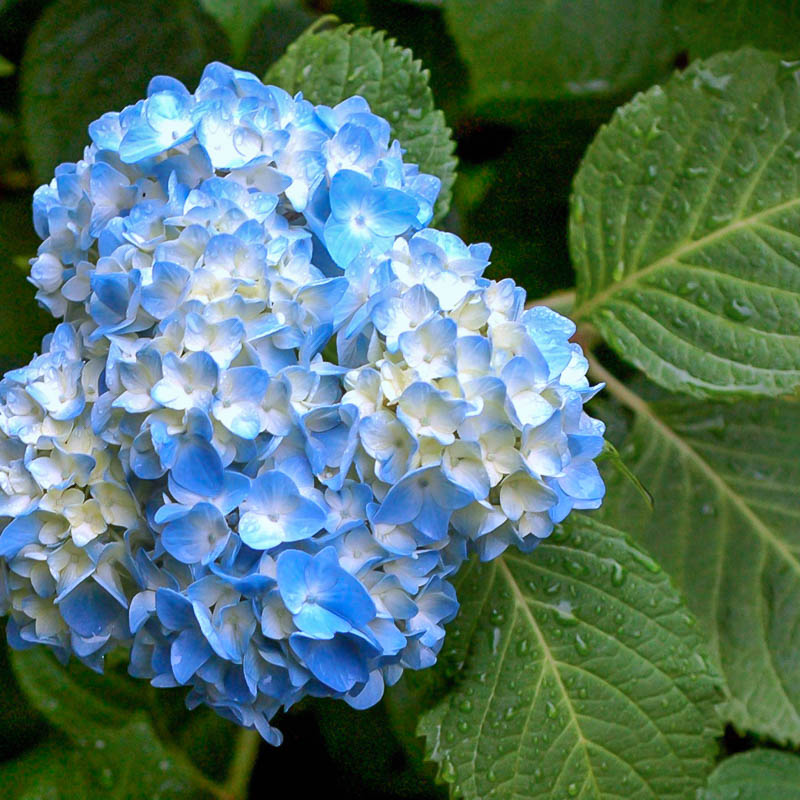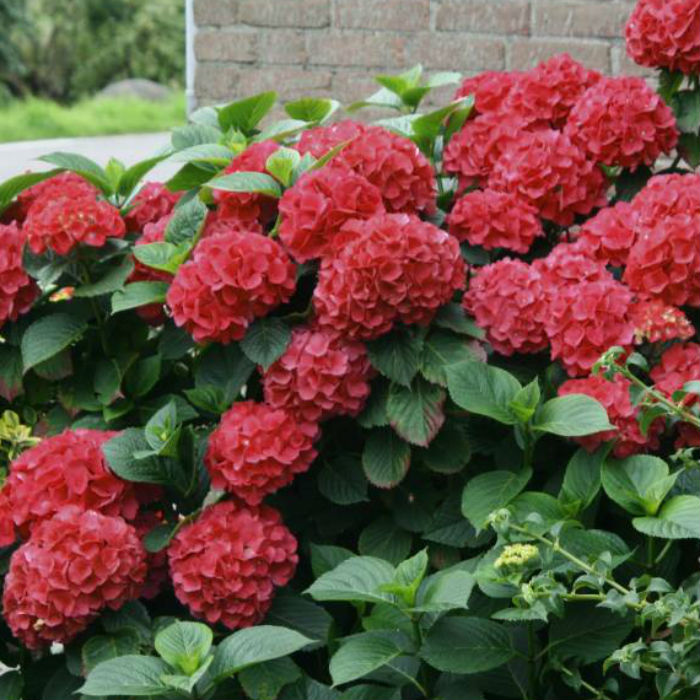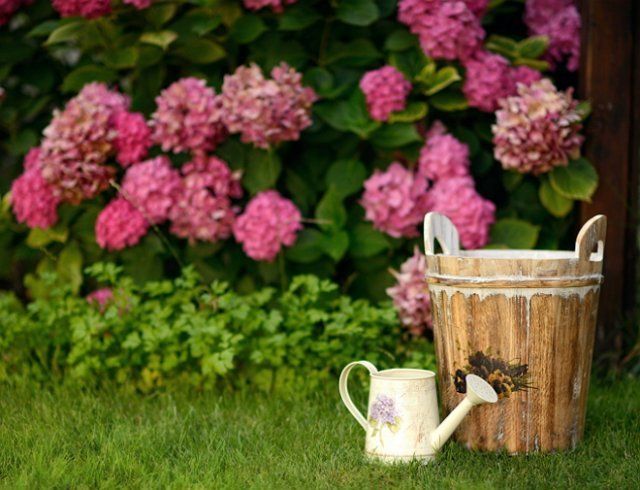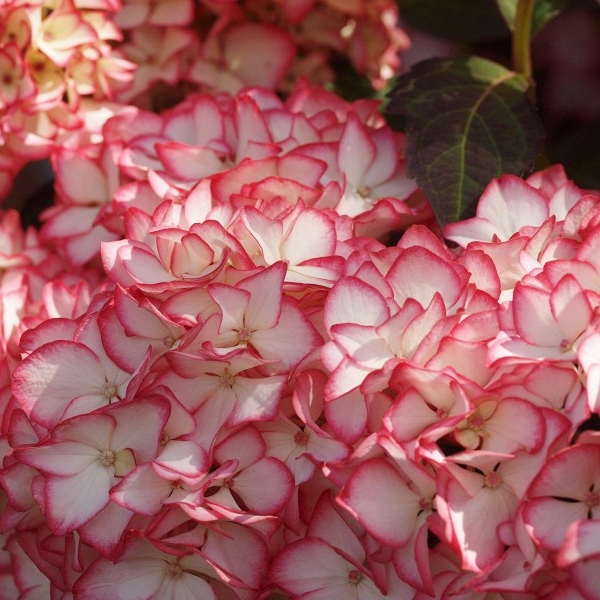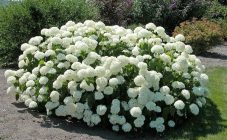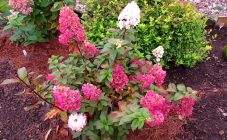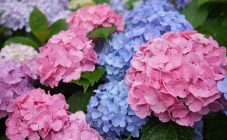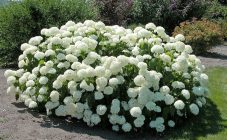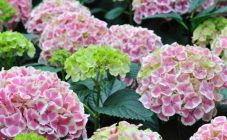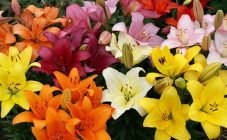Content:
Broad-leaved hydrangea is a shrub hydrangea species. There are many varieties of this crop. The flower can grow up to 3.5 meters. Recently, hydrangea has become widespread among gardeners, since it blooms for a long time and does not need special care. The only thing the plant will dry out without is watering. The soil under it must be constantly moistened.
Description of broadleaf hydrangea
Large-leaved garden hydrangea flowers differ in a variety of shades. They can be: white, cream, pink, crimson, blue, red, etc. By the color of the plant, you can tell in what soil it grows. The diameter of the flowers is about 3 cm, and the inflorescences in which the flowers are collected can reach 25 cm in diameter. The leaves of the shrub are wide, rich green, with a smooth surface.
Hortense loves sunlight. But it can be planted in a place where there is partial shade.
Hydrangea prefers slightly acidic soil. If the soil contains a large percentage of alkali, the flower will suffer from chlorosis. With this disease, the leaves turn yellow and dry. To prevent disease, it is recommended to water the plant three times a month with a solution with a high content of salts and iron. Among the varieties of hydrangeas, there are both frost-resistant and those that can only grow in greenhouse conditions. Caring for large-leaved hydrangea in the open field has some nuances. The most important thing is the correct identification of the variety in order to understand at what temperatures hydrangea can be in open soil.
Culture propagation methods
Hydrangea can reproduce in several ways:
- Cuttings;
- Seeds;
- By layering or dividing the bush.
Hydrangea large-leaved planting and care in open ground in Russia is possible only in the southern part. In Siberia and the Urals, hydrangia (this is another name for a plant) is grown in greenhouses or greenhouses and only at the beginning of the growing season is transferred to open soil, and then if the threat of severe frosts has passed.
How to plant or cut a large-leaved hydrangea in summer? Propagation of hydrangea by cuttings is optimal in the summer. You can start the procedure when the buds are forming. To obtain a cutting, a young shoot is cut, which has not yet had time to stiffen. There should be at least 3 pairs of leaves on the shoot. The first ones are deleted immediately. After that, the shoot is immersed in water with the addition of growth stimulants. Then the cutting should be planted in a container with sand or peat and covered with a greenhouse film. You can purchase a substrate for indoor azaleas and place the cuttings in it.
Reproduction of hydrangia by dividing the bush can be done in early summer. To do this, you need to dig in the lower branches of the bush to a depth of 15 cm. An incision is made at the base of the branch, into which a match is inserted. In the future, this will help the root system develop faster.For the winter, the layers should be dug up and transferred to greenhouse conditions. The cuttings can be transferred to open soil when it gets a little stronger. Planting and caring for broadleaf hydrangea does not require large energy inputs for the gardener.
Growing hydrangeas from seeds
Hydrangeas can be germinated from seeds, but they must be fresh. Otherwise, hydrangia will not grow. The seeds of this plant are not soaked before planting as they are too small. Winter is the best time to plant hydrangea seeds. It is preferable to choose light soil for sowing. It should contain peat, sand, humus and sod.
The seeds are not buried in, but are sown directly on the surface of the substrate, and sprinkled with water from above. They are covered with a greenhouse film. To prevent the seeds from getting stuck, the film must be removed 2 times a week, for a short time. When the sprouts have 2 full leaves, they can be planted in peat cups. Landing in open ground is possible only after the threat of frost has passed.
Culture care
When growing hydrangeas, you need to monitor soil moisture, soil composition, fertilizers and temperature fluctuations. If the hydrangia is planted in an unprotected, sunny place, the leaves of the plant will burn very quickly. In a heavily shaded area, the growth and flowering of hydrangia will slow down. An excellent option would be to plant the plant in partial shade. Fertilizers are applied to the soil for hydrangeas in the fall. During the winter period, they manage to nourish the soil with all the necessary vitamins and minerals, and, starting in spring, these vitamins will go directly to the flower.
Hortense doesn't like transplants. For several years, it can delight the gardener with its violent flowering, then it is recommended to update the bush. But, if the need for transplanting still exists, this should be done with minimal losses for the plant. The pit into which the adult plant will be transplanted should be prepared in the fall. The necessary fertilizers and drainage are introduced into it. It should be no worse in composition than the one in which hydrangia has grown for several years. When transplanting, the bush deepens by no more than 20 cm. The root circle is mulched.
Open ground varieties
Varieties that have high and medium winter hardiness can be grown outdoors. Recently, breeders have bred many varieties of winter-hardy hydrangeas. The most popular varieties are:
- Holiday - blooms with a gorgeous bouquet of tricolor flowers. The bushes are quite compact, reaching a height of 1.2 meters. Winter-hardy variety. Recently, it has become very popular among residents of the Moscow region.
- Shneeball is distinguished by its large, round, white flowers. Hydrangea schneeball tolerates frost well. The flowering period of the Schneebol large-leaved hydrangea is from May to the end of September.
- Ruby. Frost resistance - up to -23 ° С. The flowers are deep ruby color with dark brown veins. The flowering period is all summer. Resistant to pests. The bush needs to be pruned annually.
- Tuzday - can withstand temperatures down to -25 ° C. When the buds open, it is green with a red border along the contour of the flower. With further development, the red color spreads over the entire area of the flower. Grows up to 1 m in height. It is immune to many diseases.
- Mireille. The flowers are white with a red border. The flowering period of the Mireille hydrangea is from late June to late August.
- Red hot - red, broadleaf hydrangea. Shade-loving, but picky about the ground. Prefers black earth. It blooms magnificently throughout the summer.
Preparing hydrangeas for winter
Preparation for winter is different for different types of hydrangea. Frost-resistant varieties do not need special preparation, and thermophilic varieties need to be covered with a greenhouse film or agrofibre. The hydrangea bush, in most cases, needs to be pruned.To shelter the thermophilic varieties of hydrangia, the branches are gently pressed to the ground, covered with foil and sprinkled with fallen leaves. After the severe frosts have passed, the film can be opened.
Caring for hydrangea is easy enough. Growing hydrangia in your garden is easy. If you follow the basic rules for caring for large-leaved hydrangea, it will delight the gardener with exuberant flowering for a long time.
